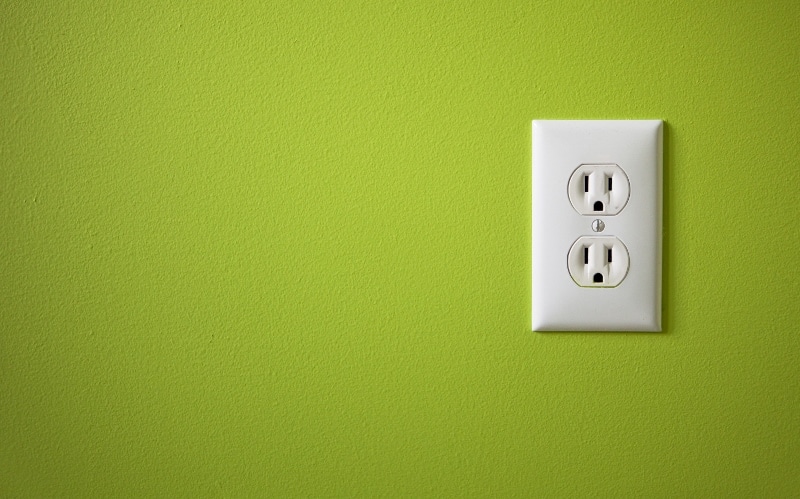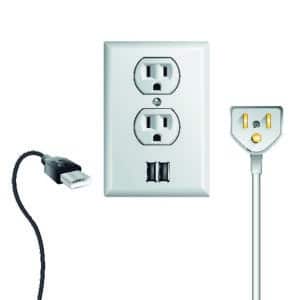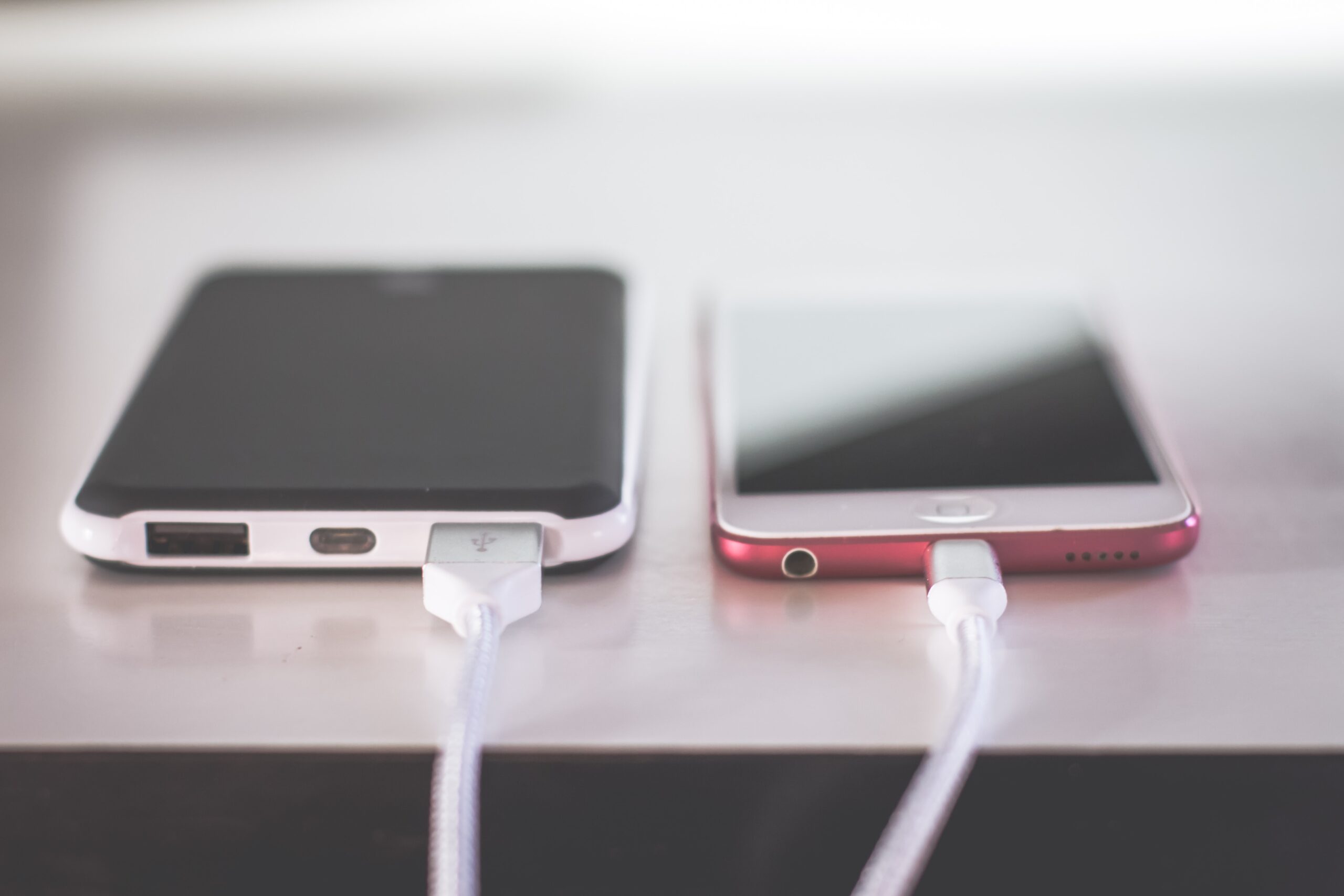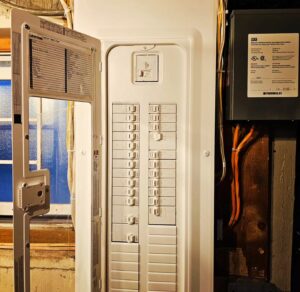
Electronic devices aren’t just changing the way we live or communicate. They are changing the way we charge. Wall outlets with adaptors have been common for years, but a demand for more convenience and faster charging is now taking over. When USB wall outlets first started appearing, it was in airports or cafes. Now, USB outlets are making their way into homes where people can access easy charging for their devices at any time.
Based on how much we depend on our smartphones, tablets and other devices, it seems that USB outlets are here to stay. As the technology for devices advances, efficient and quality USB charging is quickly becoming the new norm. Updating your electrical to include USB outlets is more than just a temporary convenience; it’s a long-term investment with great benefits.
Table of Contents
ToggleStandard outlets
If you take a look around your home right now, you’ll find that most walls have standard outlets. These outlets have three slots in them, with two on the side and one rounded one on the bottom. The two vertical slots are hot and neutral, respectively, while the bottom slot is a ground slot. The grounded slot acts as an added safety measure against any short-circuiting by redirecting the charge into the ground. Any connected devices stay safe this way, and there is no risk of being dangerously shocked.
Design
The design of a standard outlet is simple enough, but there are different styles with special features. A GFCI outlet, or ground fault circuit interrupter, has two small “reset” and “test” buttons between the slots. This type of outlet is typical in bathrooms, kitchens, or any areas where water is involved. The GFCI monitors all electricity and will trip itself and turn off if there is a dangerous surge of power.
Other types include AFCI outlets, or arc-fault receptacle, which protects homes against electrical fires. Tamper-resistant receptacle outlets are ideal for protecting children against electrical harm. The outlets have shutters built in that only open for electrical plugs and otherwise, stay sealed when not in use. For outlets placed outside of the house, there are weather-resistant ones with built-in weather hoods. These can resist rain, snow, and even moisture, and won’t corrode while outdoors.
Benefits

The main advantage of standard outlets is their wide range of designs and uses. Each room in your home can have a different outlet that will suit the space’s needs. That may mean a GFCI outlet in the bathrooms or near kitchen sinks or a weather-resistant outlet to add to your outdoor seating. All standard outlets also have three-prongs instead of two-prongs, which provide an added level of protection. Without the grounded bottom slot, two-prong outlets are at higher risk of fires, electrical surges, and costly resulting damage.
Older homes may still have two-prong outlets, which aside from being a safety risk, aren’t up to code anymore. If you have old outlets, it’s a worthwhile investment to call a professional electrician to update them. Depending on your electrical needs as well, it may be the perfect time to switch to outlets that offer a USB port as well.

USB wall outlets
USB outlets combine the design of a standard outlet, but with the added benefit of USB slots, which effectively double its function. As homes are filling more and more with various electronic devices, these outlets are becoming increasingly popular. You can have outlets installed that have both the three-pronged outlet as well as the USB ports, so you can accommodate a range of electronics. You can also have straight USB outlets installed if you wanted a designated charging station in your home.
Design
Despite not having as many diverse options for GFCI or AFCI designs, there are still various styles of USB outlets. Depending on personal needs or wants, USB outlets can easily be customized to suit those demands. The typical USB wall outlet model has two outlet slots and two USB slots in between. Other models can have two USB slots but only one outlet or have four slots of USBs only.
Kitchens, for example, typically benefit from having a four USB slot outlet as a dedicated charging station. Likewise, a home office, where various devices need to power, would benefit from an additional USB only outlet. USB wall outlets can also come with tamper-resistant designs, to help keep them safe around children.
Benefits

One of the main advantages of owning an electrical outlet with USB is the lack of bulk or need for adaptors to charge your devices. Instead, cables are plugged straight into the USB port, saving both space and visual clutter. Not only that, but USB outlets charge faster than through an adaptor, as much as 40 percent faster. The reason being is that most USB outlets have a smart detector that optimizes the amount of power needed to charge the device. Similar to the variety of designs with standard outlets, the various number of USB outlets can be customized. Each room can have a different style to better suit each need, no matter where you are in your home.
USB outlets will also vary based on their USB ports, which depending on the model, will affect what cables will fit. For USB wall outlet connections, there is either USB-A or USB-C. Depending on the style of your USB outlet, it may come with just type A or have both type A and C. Before you buy a new outlet, it’s necessary to understand the differences so you can buy the right style.
Difference between USB-A and USB-C
In addition to type A and type C, there is also USB-B. However, type B is for connecting printers, computers, or external hard drives. The design itself is also recognizable by its squared appearance, compared to the smaller and slimmer design of type A or C. Because type B is used for connecting and not charging, USB outlets don’t use type B.
USB-A
Type A is the most common type of USB and is easy to recognize on most USB ports on laptops and computers. The design is identifiable by its small, rectangular shape and grids on one side inside the head. These grids make it notoriously one-sided, meaning it has to be put in the right side up before the USB plugs in. Most laptops still have a type-A slot, but as charging sizes have changed, especially for phones, two new styles of type A were developed: micro and mini.
Mini USB-A: Mini USBs were first introduced back in 2005 and are much smaller than the traditional type A. Despite having slightly less power, the smaller size means more compatibility for more devices. Everything from cell phones, cameras, and mp3 players can be charged with the mini. Additionally, they have a much longer lifespan and can be connected and disconnected upwards of 5,000 times before showing wear.
Micro USB-A: The micro USB was released in 2007 and is essentially a newer and more efficient version of the mini USB. It is the smallest of the three but is quickly becoming the universal design for USB ports and cables. Micro USBs are also much more robust and long-lasting with a connect and disconnect lifespan of upwards of 10,000 times. It can also transport data in addition to working as a charging cable. Mini USBs are still around, but they are steadily becoming obsolete in favour of the micro.
Most USB outlets come with at least one of the two USB slots being a type A, which allows older phones or laptops to still charge at the outlet. However, the type-A slot isn’t split between micro or mini support. Instead, the secondary slot is compatible with type C, which acts as the all-in-one updated version of a type-A USB.
USB-C
Type C ports are much newer models that are more and more becoming the new standard for cell phones, controllers, and even laptops. Unlike type A as well, USB-C can work for both charging and data transfer, much like the micro USB. Another attractive key feature is its slimmer design and lack of interior grids, meaning there is no right or wrong side. Whichever way it’s plugged in, it will work. As an updated model, the USB-C offers a much faster charging speed than the USB-A. It is also universal across most products, from Apple, Microsoft, and Samsung, so no device is excluded from use.
Because USB-C is still relatively new to the technological scene, USB outlets still offer both type A and C slots. Depending on the types of devices in your home, you may need to use both types of slots. As the popularity of USB-C is still growing, it’s a safe bet to buy an outlet with both.

Signs you should upgrade your outlets
Most of the time, outlets are used without much thought, at least until something goes wrong. Discoloration has appeared on the walls, for example, the plug falls out right away, or there’s smoke from the outlet in severe cases. In situations like these, calling in an electrician for help is the safest and obvious course of action. But just because your outlets aren’t in trouble and work, doesn’t mean they are still meeting your needs. Broken outlets are a great excuse to update them, but don’t let that be the only reason. As technology advances and new needs arise, consider some other signs that it’s time for an update:
1. Time to declutter
Is the area around your wall outlets turning into a cluttered mess? If so, it’s time to update the outlet with something more efficient. By installing USB electrical outlets, you’ll free up a ton of counter space by not needing all those adaptors and cables. You can also choose where to add your new USB outlet so that appliances and devices aren’t competing for use or space.
2. You want more convenience
Instead of constantly having to unplug other cables before you can charge your phone, a USB outlet saves that trouble. If you have a home office, you can plug in your computer, printer, and phone without a second thought. Not only that, but every device will charge just as fast, even with simultaneous charges. Install multiple USB outlets throughout your home, so you never find yourself without a convenient place to charge.
3. The power just isn’t enough
Charging your device through a wall adaptor may be faster than through a laptop, but it still takes time. With a USB electrical outlet not only will it charge faster, but you can charge more. USB outlets are optimized to feed enough power to a device to charge it quickly. Instead of relying on power cords or extension cords, a USB outlet will cover it all. It’s also safer to use than extension cords, which can eventually deteriorate and result in safety issues.
What to look for in a USB outlet
Once you’ve settled on upgrading to USB electrical outlets, it’s time to know what to look for. Everything from the electrical rating or number of USB slots must be taken into consideration first.
Choose higher amperage
Don’t worry about overloading your device by choosing a high amperage USB outlet. The USB port itself will recognize how much power a device needs and will only deliver the safest amount. By selecting the highest amperage, you can ensure the fastest possible charging speed for your device. Each USB port will split the total charge between the two, so a higher overall number means an even split. Amperage can range from 1.0a/2.0a up to a 4.8a power charge. Depending on what and how many devices you plan to charge, you may want more power.
Decide on the number of USB slots
Depending on where in your house your plan to install a USB outlet, it’ll affect how many slots you need. For a home office, you want an even split between USB and three-prong sockets. A kitchen, though, may benefit from a dedicated charging station with just USB slots. Plan which rooms will benefit the most from a USB electrical outlet, then settle on the number. Also, take a look at what type of USB slots are offered, whether its two type A or one type A and one type C. Depending on what devices you own, you may only need type A USB slots. If your household has a blend, buy a USB outlet that offers both types of slots.
What safety features do you want
USB outlets don’t have as many varieties as standard outlets, but there are still some safety features to consider. A surge protector USB, for example, will offer an added layer of protection for your device against power surges. If you have small or visiting children, then a USB outlet with tamper resistance is ideal. For double the protection, buy a USB outlet that offers both surge and tamper protection.
Don’t skip out on cost either by choosing the cheapest option or an uncertified one. With electronics, it’s always safer to choose a slightly more expensive option, as an investment that isn’t low-quality and risky. Certifications such as UL and NEC code outlets will guarantee that your outlets are up to standard and so safe for your home and devices.
Safety first: leave it to the pros
It may be true that installing new outlets is an easy matter, but that doesn’t mean you should DIY it. Without the right safety experience and electrical knowledge, there is a bigger risk of installing the outlet wrong and inviting unnecessary danger. Not only that, but it can affect
the value of your home if the outlets aren’t up to electrical safety codes. Instead, call a professional electrician to handle the installation for you. Their experience and skill will ensure everything is properly installed so that your home and family stay safe.
Find a RenovationFind certified electrician in your area!
| Alberta | British Columbia | Saskatchewan |
| Edmonton Electricians | Kelowna Electricians | Regina Electricians |
| Calgary Electricians | Vancouver Electricians | Saskatoon Electricians |
| Victoria Electricians | ||
| Manitoba | Nova Scotia | Newfoundland |
| Winnipeg Electricians | Halifax Electricians | St. John’s Electricians |
| Ontario | Quebec | New Brunswick |
| Toronto Electricians | Montreal Electricians | Fredericton Electricians |
| Barrie Electricians | Quebec City Electricians | Moncton Electricians |
| Hamilton Electricians | Saint John Electricians | |
| Kitchener Electricians | ||
| London Electricians | ||









